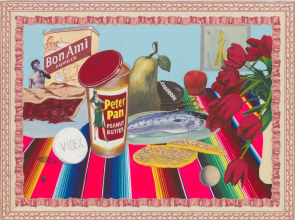
Artist Joey Terrill in his studio on the occasion of the opening of Joey Terrill: Still Here at Marc Selwyn Fine Art.
Transcript
Joey Terril: I started the still life series in 1997, when, at that moment, I tested undetectable for the HIV virus…and the realization that I was not going to die. But it was a moment that really left me feeling ambivalent and perplexed about, you know, why did I survive? And all my friends that didn't and are no longer here?
You know, but I am still here and I'm here because of these medications I couldn't think of a way to do one photo or image source to convey the complexities of what I was feeling and I was sitting at my breakfast table pondering this in my head and looking at my Cheerios, looking at my HIV meds at the breakfast table and I thought, ‘Oh my God, this is so funny. It looks like a Tom Wesselmann still-life.’ And the light bulb went off in my head. I thought that's it. I will do a version of a Tom Wesselmann-like still life that incorporates HIV meds.
That was my way of, you know, familiarizing the HIV meds as part of an everyday domestic scene, having breakfast. But I also would then be able to critique the pharmaceutical industry that makes billions off of these medications.
Starting in 2023, I'm going in a direction where I'd like each of the still-lifes to honor or mention artists who died from AIDS.
I feel that if I have survived, whereas so many artists in the arts community have not, then I feel like it's up to me to go ahead and just kind of remind people that these are artists that I don't want to be forgotten.
None of the still-lifes would ever be accused of being serene or peaceful. I mean, my intention is to juxtapose as many surfaces, colors, mediums, as possible to make them visually challenging.
I also did include in this latest one that I did in 2023, an image of Michelangelo's David, because like many folks, I was outraged when I heard about a teacher in Florida getting chastised because she dared to show David to her students.
I also intentionally wanted to both, what I call queerize and Mexicanize, my still-lifes, so that no one would mistake them for, like they would, Tom Wesselmann. And so, each one of my still-lifes was going to start out with a foregrounded tabletop covered in a Mexican serape blanket. I think they invigorate and provide some energy, and maybe even a lot of kinetic chaos to the works. Because I wasn't using one photograph or image source, it freed me up to play and go in directions that I hadn't thought of before.
So, I started to wallpaper the backgrounds with actual real wallpaper. For about eight years, my partner Rick, and I used to hang wall covering. We were paper hangers that would get jobs from Beverly Hills to Santa Barbara to Whittier, downtown LA, Santa Monica, and they were all these big and high-end jobs with this beautiful, beautiful wallpaper.
And, you know, I, and I have to say that, you know, I grew up on the East side, East LA, my parents are working class, you know, but we would get these jobs in, you know, huge, huge mansions and we would be in locations and homes that I knew that there was no way that I would ever have a social access to. Sometimes, believe it or not, we could even talk about the art that they had on their walls, which, you know, no one in my neighborhood had a Rothko or a Hockney hanging on their walls.
So, that is a reference for me indicating that discrepancy between my socioeconomic status and then this access into these upper middle class or very wealthy homes.
I also started to include in some of them images of art on the walls, just to bring in again, this sense of having a domestic space where art was important.
And looking for products to put into my still-lifes, I started to look up old and vintage products that I grew up with, so when you see the advertisements and most of these, they're from either the late fifties or 1960s.
With the still-lifes, I am referencing my specific, you know, Chicano or Mexican heritage and in them, by placing American products next to Mexican products, or products that are familiar with Chicanos, that again, to me is an indication of my dual identity.
I also then started to look at representations of flowers and fruits and vegetables from old advertising, as well as Dutch still lifes, memento moris. I started to look at the whole history of still lifes. And that, for me, that whole process is really fun. It's fun for me to be able to kind of pick and choose and place and move things around.
My goal in these is to have items that, at the same time that they are familiar, certainly as individual items, when juxtaposed against all these other items, become somewhat surreal and enigmatic.
Joey Terrill: Still Here is on view from January 13th - March 3rd, 2024 at Marc Selwyn Fine Art.
Videography by Lucas Horowitz
Music by Sean Brin
